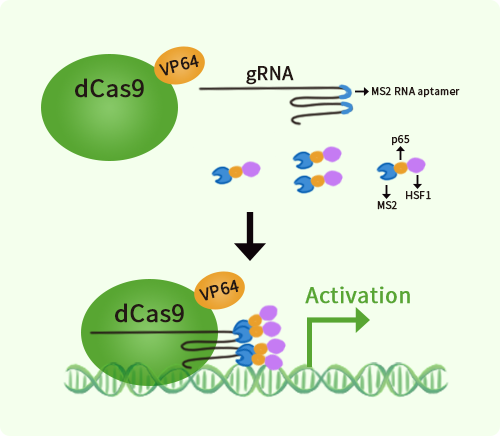Human Acid Phosphatase 2 (ACP2) activation kit by CRISPRa
CAT#: GA100041
ACP2 CRISPRa kit - CRISPR gene activation of human acid phosphatase 2, lysosomal
Find the corresponding CRISPRi Inhibitor Kit
USD 1,290.00
2 Weeks*
Specifications
| Product Data | |
| Format | 3gRNAs, 1 scramble ctrl and 1 enhancer vector |
| Symbol | ACP2 |
| Locus ID | 53 |
| Kit Components | GA100041G1, Acid Phosphatase 2 gRNA vector 1 in pCas-Guide-GFP-CRISPRa GA100041G2, Acid Phosphatase 2 gRNA vector 2 in pCas-Guide-GFP-CRISPRa GA100041G3, Acid Phosphatase 2 gRNA vector 3 in pCas-Guide-GFP-CRISPRa 1 CRISPRa-Enhancer vector, SKU GE100056 1 CRISPRa scramble vector, SKU GE100077 |
| Disclaimer | The kit is designed based on the best knowledge of CRISPa SAM technology. The efficiency of the activation can be affected by many factors, including nucleosome occupancy status, chromatin structure and the gene expression level of the target, etc. |
| Reference Data | |
| RefSeq | NM_001131064, NM_001302489, NM_001302490, NM_001302491, NM_001302492, NM_001610, NM_001357016 |
| Synonyms | acid phosphatase 2, lysosomal; Acp-2; LAP; OTTMUSP00000015308 |
| Summary | The protein encoded by this gene belongs to the histidine acid phosphatase family, which hydrolyze orthophosphoric monoesters to alcohol and phosphate. This protein is localized to the lysosomal membrane, and is chemically and genetically distinct from the red cell acid phosphatase. Mice lacking this gene showed multiple defects, including bone structure alterations, lysosomal storage defects, and an increased tendency towards seizures. An enzymatically-inactive allele of this gene in mice showed severe growth retardation, hair-follicle abnormalities, and an ataxia-like phenotype. Alternatively spliced transcript variants have been found for this gene. A C-terminally extended isoform is also predicted to be produced by the use of an alternative in-frame translation termination codon via a stop codon readthrough mechanism. [provided by RefSeq, Oct 2017] |
Documents
| Product Manuals |
| FAQs |
Resources
Other Versions
| SKU | Description | Size | Price |
|---|---|---|---|
| KN410562 | ACP2 - KN2.0, Human gene knockout kit via CRISPR, non-homology mediated. |
USD 1,290.00 |
{0} Product Review(s)
Be the first one to submit a review






























































































































































































































































 Germany
Germany
 Japan
Japan
 United Kingdom
United Kingdom
 China
China
